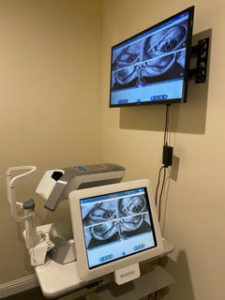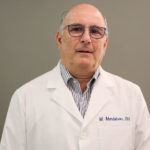
The LipiView in Dr. Mendelson’s office. Dr. Mendelson says instrumentation like this helps his practice grow in the services it provides while greatly boosting profitability.
By Moshe Mendelson, OD, FIAO
Sept. 29, 2021
The investments you make in your practice should enable you to better care for patients and to become more profitable. I have made three critical investments in my practice that allow me to provide a higher level of care for patients while generating significant revenues.
Lipiscan & Lipiflow
Lipiscan is a tool which enables patients to view their own miebomian glands and compare their own glands to what are considered to be normal glands. Presenting this information results in patients moving toward compliance with your treatment plan because they are made to understand the need for it.
I am able to identify meibomian gland disease (MGD) before patients experience dry eye symptoms and offer preventive care. All patients who present for their annual eye exam in my practice benefit from a complimentary Lipiscan.
If the findings of the Lipiscan warrant it, patients are prescribed a Lipiflow treatment. Lipiflow is one of the tools that provides the standard of care for treatment of obstructed miebomian glands.
Cost: $60,000 for this suite of instruments; it is less expensive now. I paid for this purchase outright, putting the charge on my practice credit card.
ROI: It took five months to break even on this technology. It started generating a profit for us at the six-month point. Annual profitability resulting from this investment totals at least $100,000.
Deficient Lipiscan findings demonstrate to the patient the need for further evaluation and testing for which the patient is scheduled for a separate medical visit. At least 20 percent of my patients who obtain the Lipiscan show signs of MGD.
This medical visit, which consists of medical examination and evaluation with initiation of diagnostic and treatment program, can be billed to medical insurance as a 92002 visit when appropriate.
Subsequently, patients will be prescribed nutraceuticals, lid hygiene products or treatment such as BlephEx or Lipiflow. These are all private-pay treatments. Lipiflow alone generates $100,000+ annually.
Topographer as Primary Myopia Management & Specialty CL Services Tool
A topographer is a tool that is helpful in providing myopia management solutions, as well as for specialty contact lens fittings. The greater accuracy in fitting contacts for myopia management and specialty contact lenses results in better and quicker treatment outcomes, which leads to happy patients who return to my office and refer many others.
To optimize use of a topographer, I recommend sharing with patients the topographical images of the cornea and explaining how you use these images for better treatment design and outcomes. This gives patients a greater sense of the value and reliability of your services.
Cost: $12,000. I paid cash for this investment.
ROI: 2-3 months to break even. Money is generated immediately, however, as this technology minimizes exam room chair time. The topographer is a key tool in my myopia management center, which means it is one of the resources contributing to a practice niche that generates around $1 million annually.
Other Articles to Explore
Topography has been instrumental in my practice in the design of specialty contact lenses for individualized myopia management solutions, as well as for designing specialty lenses for various corneal pathologies. It enables me to custom design lenses and minimize chair time and lens re-dos, which are expensive. Further, I find that demonstrating to parents their child’s specific topography, and educating them on how I’m using this information for better outcomes, is a practice-builder.
OCT
An OCT allows for early detection of internal ocular conditions which may lead to vision impairment. It is particularly useful in identifying and monitoring retinal and glaucoma disease.
All patients who visit my office for their annual eye exam are offered an OCT screening, which comes with an out-of-pocket fee, as it is not covered by insurance.
Cost: $65,000. I paid for this instrument outright, putting it on my practice credit card.
ROI: It took six months to break even from this investment. We began to profit after that point. This instrument now generates at least $100,000 annually in my practice.
About one-third of my patients opt in for this screening. Additionally, you can bill medical insurance for retina and glaucoma surveillance when indicated.
My success with these three instruments shows that targeted investments that elevate patient care can also be a tremendous boost to practice growth and profitability, reinforcing the old adage, “What’s good for the patient is good for the practice.”
 Moshe Mendelson, OD, FIAO, is a partner with Silicon Valley Eye Physicians. To contact him: m.mendelson@sbcglobal.net
Moshe Mendelson, OD, FIAO, is a partner with Silicon Valley Eye Physicians. To contact him: m.mendelson@sbcglobal.net

























